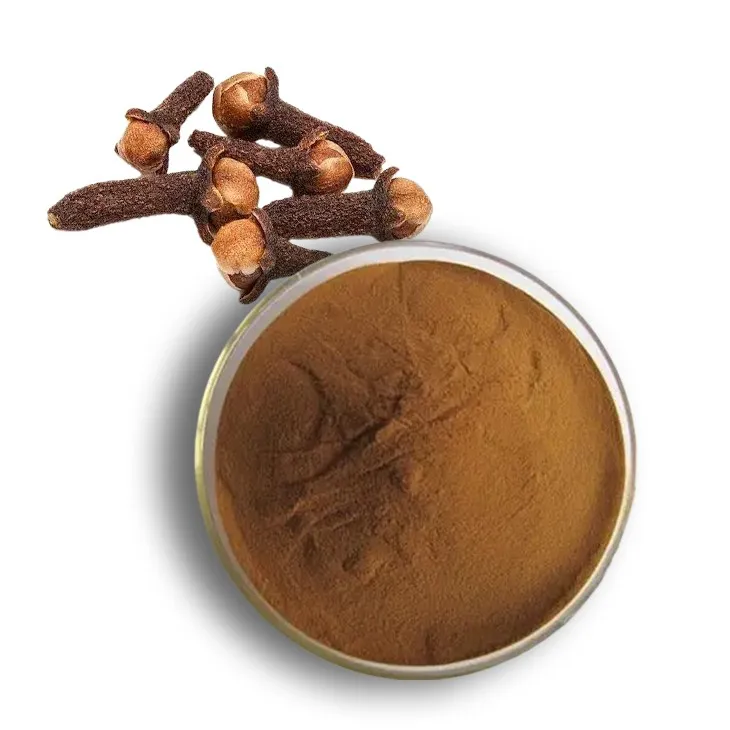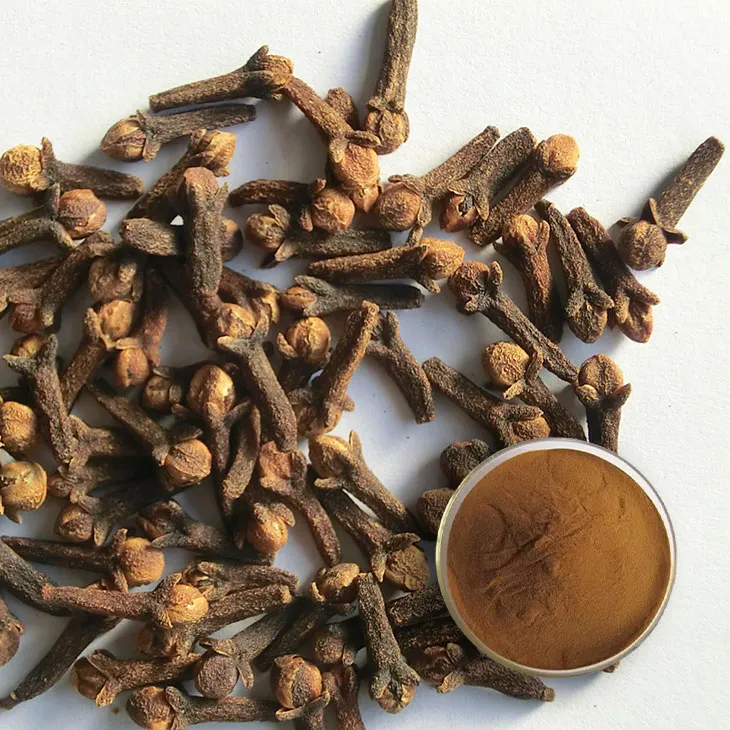- 0086-571-85302990
- sales@greenskybio.com
The process of extracting eugenol from clove powder.
2024-11-29

1. Introduction to Clove Powder and Eugenol
Clove Powder is a product derived from cloves, which are the dried flower buds of the Syzygium aromaticum tree. Clove Powder contains a variety of chemical components, among which eugenol is a particularly important and valuable one. Eugenol is a phenylpropanoid compound with a characteristic spicy and pleasant aroma. It has a wide range of applications in various fields, such as in the food industry as a flavoring agent, in the perfume industry for its unique scent, and in the pharmaceutical field for its potential medicinal properties.

2. Main Extraction Methods
2.1 Steam Distillation
Advantages:
- Steam distillation is a traditional and widely used method. It is relatively simple and does not require complex equipment. The basic principle is that when steam is passed through the clove powder, eugenol, which has a certain volatility, will vaporize along with the steam due to its relatively low boiling point. Then, the vapor mixture can be condensed and collected, and eugenol can be separated from the water - eugenol mixture.
- It is a relatively clean method, as it does not introduce many impurities during the extraction process. This is because steam is used as the medium for extraction, and it is generally pure water vapor.
- The extraction efficiency may not be very high. Since the process depends on the volatility of eugenol, some eugenol may not be completely vaporized and thus left in the clove powder residue.
- It is a time - consuming process. The slow passage of steam through the clove powder and the subsequent condensation steps require a relatively long time to complete the extraction.
2.2 Solvent Extraction
Advantages:
- Solvent extraction can achieve relatively high extraction efficiency. Organic solvents such as ethanol or ethyl acetate can dissolve eugenol effectively. These solvents can penetrate into the clove powder matrix more thoroughly, thus extracting a larger amount of eugenol compared to steam distillation in a relatively short time.
- The selectivity of solvent extraction can be adjusted. By choosing different solvents or solvent mixtures, it is possible to selectively extract eugenol while leaving some other components in the clove powder. This is useful for obtaining a relatively pure eugenol extract.
- The use of solvents may introduce safety risks. Many organic solvents are flammable and volatile, which require strict safety measures during the extraction process to prevent fires and explosions.
- There is a problem of solvent residue. After the extraction, it is necessary to remove the solvent completely from the eugenol - rich extract. If the solvent residue is not removed thoroughly, it will affect the quality of the final eugenol product, especially in applications where high purity is required, such as in the pharmaceutical industry.
2.3 Supercritical Fluid Extraction
Advantages:
- Supercritical fluid extraction, especially using supercritical carbon dioxide (scCO₂), offers high extraction efficiency. scCO₂ has properties between a gas and a liquid at its supercritical state. It can penetrate the clove powder matrix well and dissolve eugenol effectively.
- It is a clean extraction method. Since CO₂ is non - toxic, non - flammable, and can be easily removed from the extract by simply reducing the pressure, there is no solvent residue problem in the final product.
- The extraction process can be controlled precisely. By adjusting parameters such as temperature, pressure, and flow rate of the supercritical fluid, the selectivity and extraction efficiency can be optimized.
- The equipment for supercritical fluid extraction is relatively expensive. It requires high - pressure vessels and precise control systems, which increase the initial investment cost.
- The operation process is more complex. It needs well - trained operators to ensure the correct operation of the equipment and the stability of the extraction process.

3. Post - extraction Handling of Eugenol - rich Extracts
3.1 Concentration
After the extraction of eugenol from clove powder, the resulting extract usually contains a certain amount of water or solvent, depending on the extraction method used. To obtain a more concentrated eugenol product, concentration processes are required. For extracts obtained by steam distillation, methods such as evaporation under reduced pressure can be used. By reducing the pressure, the boiling point of the water - eugenol mixture is lowered, which allows the water to be evaporated more easily at a lower temperature, thus concentrating the eugenol. In the case of solvent - extracted extracts, the solvent can be removed partially or completely by distillation under appropriate conditions to increase the concentration of eugenol.
3.2 Purification
Purification is an important step to obtain high - quality eugenol. The eugenol - rich extract may contain some impurities such as other phenolic compounds or non - volatile substances from the clove powder. One common purification method is fractional distillation. Since different components have different boiling points, by carefully controlling the temperature during distillation, eugenol can be separated from other components with relatively close boiling points. Another method is chromatography, such as column chromatography. In column chromatography, the eugenol - rich extract is passed through a column filled with a stationary phase. Different components in the extract will interact differently with the stationary phase, and thus can be separated, allowing for the purification of eugenol.

4. Future Prospects of Eugenol Extraction Technology
4.1 Efficiency Improvement
In the future, there is a great potential for improving the efficiency of eugenol extraction. One direction is the development of new extraction techniques or the improvement of existing methods. For example, researchers may explore new solvent systems or modified supercritical fluid extraction conditions to enhance the extraction yield of eugenol. Another aspect is the optimization of the extraction process parameters. By using advanced data analysis and modelling techniques, such as response surface methodology, the optimal combination of parameters such as temperature, pressure, and extraction time can be determined more accurately to maximize the extraction efficiency.
4.2 New Application Development
As research on eugenol continues, new applications are expected to be discovered. In the field of medicine, eugenol may be further explored for its anti - inflammatory, antibacterial, and antioxidant properties. It may be developed into new drugs or incorporated into existing pharmaceutical formulations. In the food industry, with the increasing demand for natural flavorings and preservatives, eugenol could be used in new food products or in new ways to enhance food quality and shelf - life. In addition, in the cosmetic industry, eugenol may find new applications in skincare products due to its potential to soothe the skin and protect against environmental damage.
FAQ:
What is the main chemical composition of clove powder?
Clove powder contains various components. The main ones include eugenol, which can account for a significant portion. It also has other substances like acetyl eugenol, beta - caryophyllene, and some tannins. Eugenol is of particular interest due to its numerous properties such as having a characteristic smell and potential applications in various industries like the flavor, fragrance, and pharmaceutical industries.
Why is eugenol a valuable component to be extracted from clove powder?
Eugenol has a wide range of applications. In the food industry, it is used as a flavoring agent, adding a characteristic spicy and warm flavor. In the perfume and cosmetic industries, it can contribute to pleasant fragrances. In the pharmaceutical field, it has antibacterial, antifungal, and anti - inflammatory properties. Thus, extracting eugenol from clove powder is valuable for these diverse industrial uses.
What are the main extraction methods of eugenol from clove powder?
There are several main extraction methods. One common method is steam distillation. Its advantage is that it is a relatively simple and traditional method that can be used on a large scale. However, it may require a long extraction time and some eugenol may be lost during the process. Another method is solvent extraction. It can use solvents like ethanol. The advantage is that it can achieve a relatively high extraction yield in a shorter time, but the disadvantage is that the solvent needs to be removed completely in the subsequent process, and there may be some solvent residues if not handled properly.
How to concentrate the eugenol - rich extracts after extraction?
One common method for concentrating eugenol - rich extracts is through evaporation. This can be done under reduced pressure, which helps to lower the boiling point of the solvent and eugenol mixture, allowing for more efficient evaporation without causing thermal degradation of eugenol. Another approach is using membrane separation techniques, which can selectively separate and concentrate eugenol based on the molecular size differences between eugenol and other components in the extract.
What are the methods for purifying eugenol after extraction?
For purifying eugenol, distillation can be carried out multiple times to increase the purity. Another method is chromatography, such as column chromatography. In column chromatography, a stationary phase is used, and eugenol can be separated from other impurities based on its different affinities to the stationary phase. Crystallization can also be used in some cases, where eugenol is allowed to form crystals, separating it from the remaining liquid components.
Related literature
- Eugenol: A Multifunctional Molecule with Therapeutic and Industrial Applications"
- "Advances in the Extraction of Eugenol from Natural Sources"
- "The Chemistry and Applications of Eugenol in the Food and Pharmaceutical Industries"
- ▶ Hesperidin
- ▶ Citrus Bioflavonoids
- ▶ Plant Extract
- ▶ lycopene
- ▶ Diosmin
- ▶ Grape seed extract
- ▶ Sea buckthorn Juice Powder
- ▶ Fruit Juice Powder
- ▶ Hops Extract
- ▶ Artichoke Extract
- ▶ Mushroom extract
- ▶ Astaxanthin
- ▶ Green Tea Extract
- ▶ Curcumin
- ▶ Horse Chestnut Extract
- ▶ Other Product
- ▶ Boswellia Serrata Extract
- ▶ Resveratrol
- ▶ Marigold Extract
- ▶ Grape Leaf Extract
- ▶ New Product
- ▶ Aminolevulinic acid
- ▶ Cranberry Extract
- ▶ Red Yeast Rice
- ▶ Red Wine Extract
-
White Willow Bark Extract
2024-11-29
-
Mango flavored powder
2024-11-29
-
Green coffee bean Extract
2024-11-29
-
Okra Extract
2024-11-29
-
American Ginseng Root Extract
2024-11-29
-
Hawthorn powder
2024-11-29
-
Tormentil Extract
2024-11-29
-
Peppermint Extract Powder
2024-11-29
-
Almond Extract Powder
2024-11-29
-
Yam Extract
2024-11-29





















